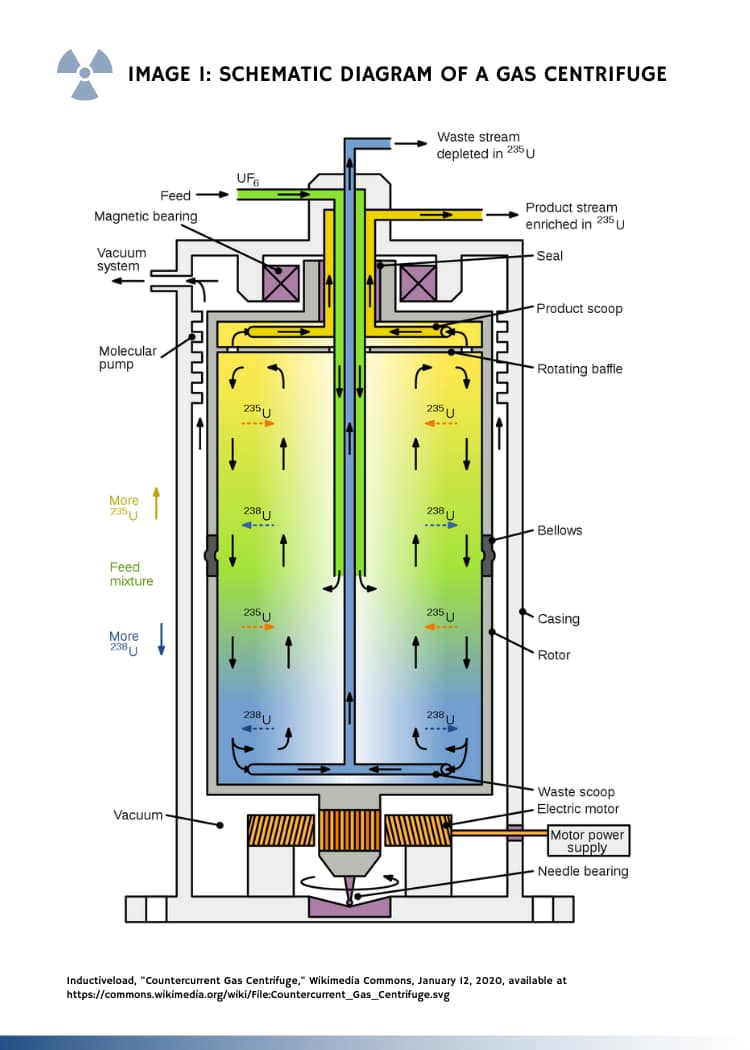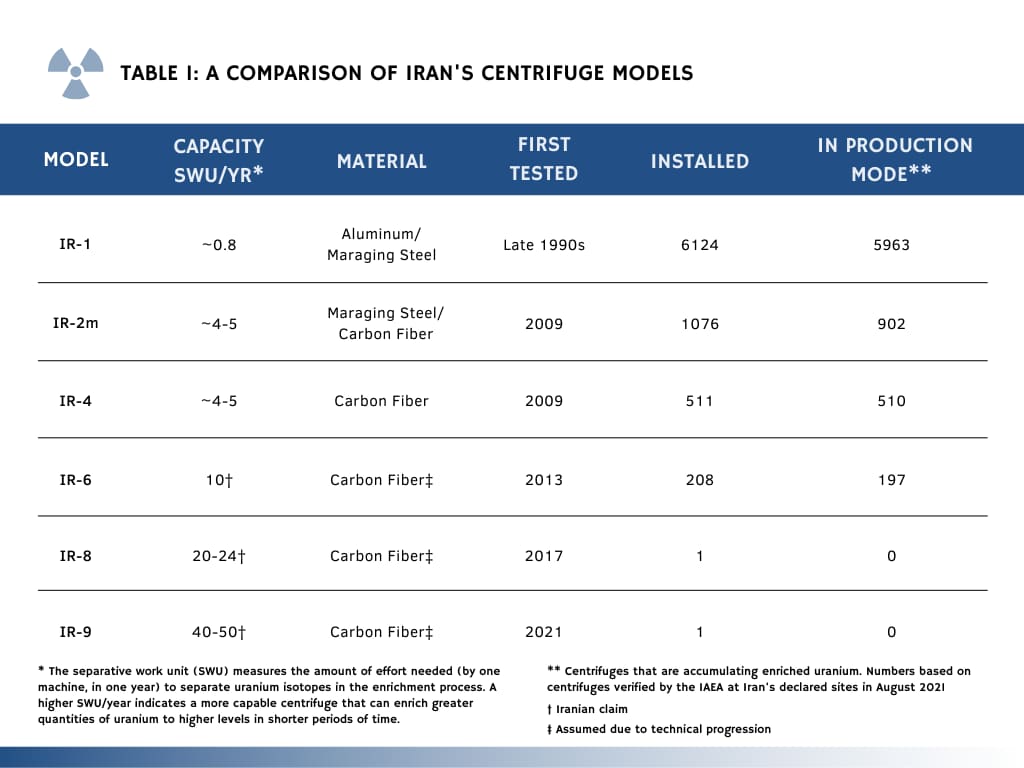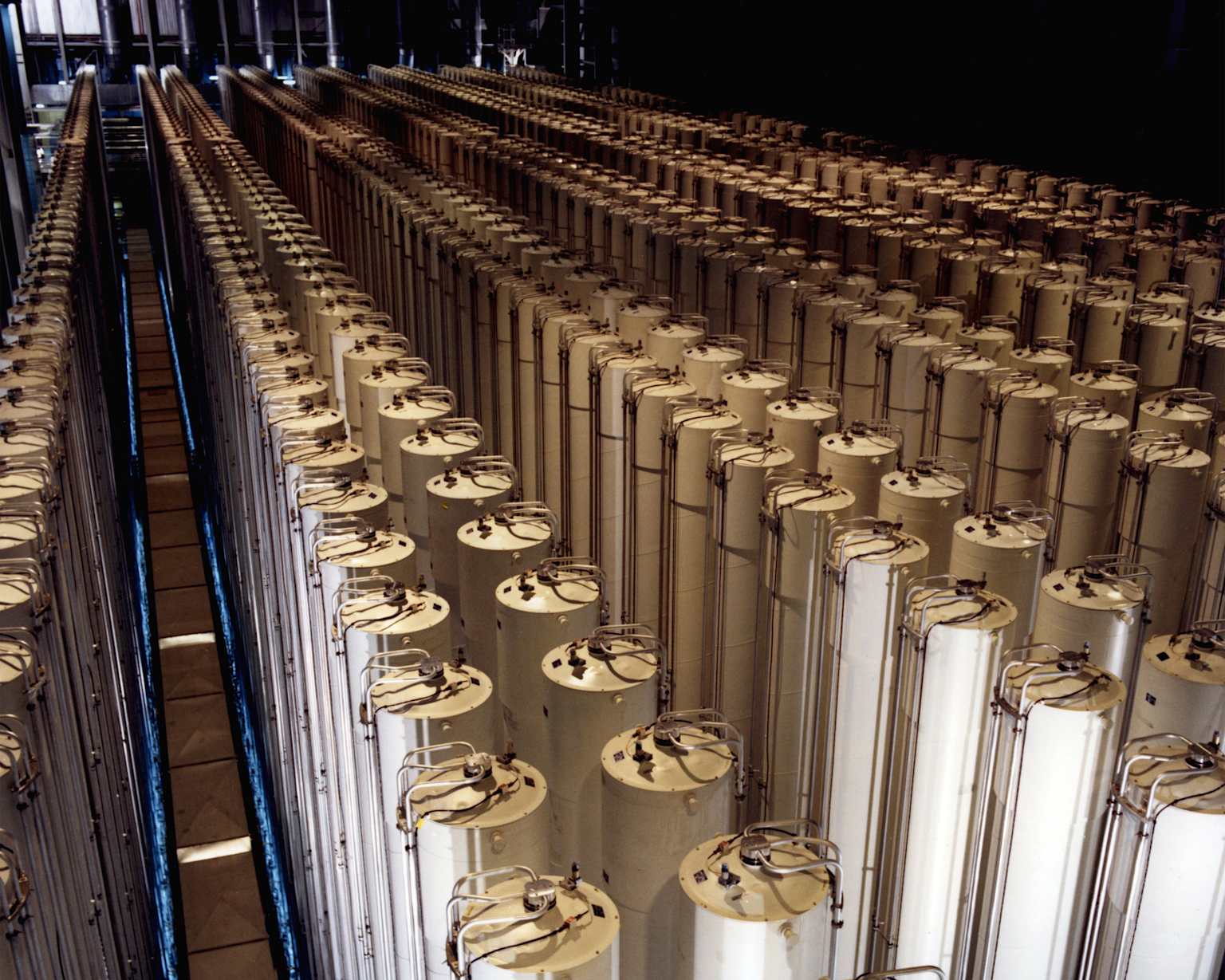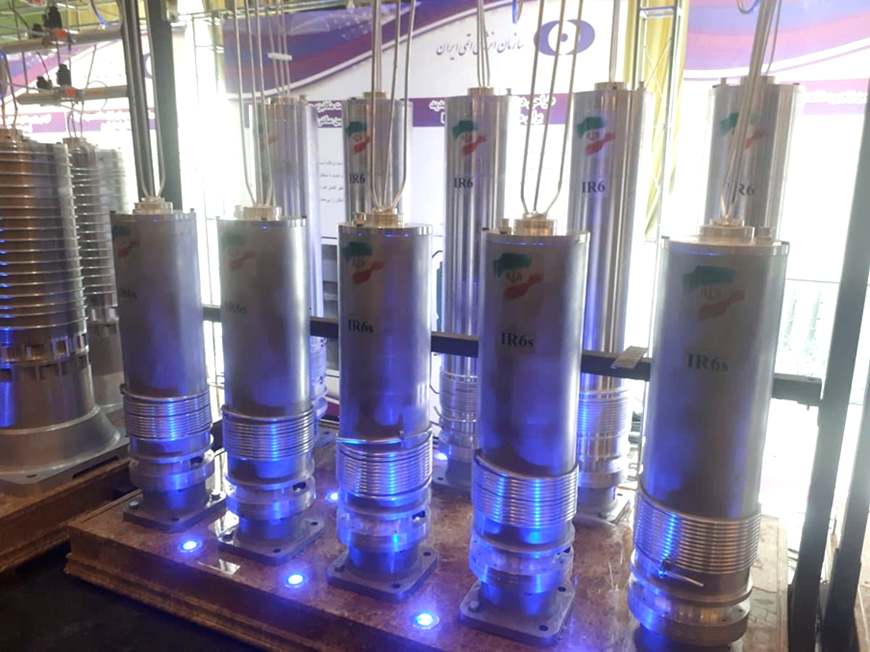The IR-1 centrifuge represents the cornerstone of Iran’s uranium enrichment program, serving as the workhorse of its nuclear ambitions despite numerous technical limitations 12. As Iran’s first deployed centrifuge model, the IR-1 has played a pivotal role in the country’s controversial nuclear program and continues to operate at facilities like Natanz and Fordow, even as more advanced models are being developed 34.
This article examines the origins, specifications, and significance of the IR-1 centrifuge, providing insight into this first-generation technology that has been at the center of international concerns over nuclear proliferation 56.

Schematic diagram illustrating the operation of a countercurrent gas centrifuge, detailing the components and process of uranium isotope separation.
Origins and Development
The IR-1 centrifuge is not an indigenous Iranian design but rather a copy of Pakistan’s P-1 centrifuge, which itself was derived from stolen Dutch designs 78. The technology transfer occurred through the notorious nuclear proliferation network led by Pakistani nuclear scientist Abdul Qadeer Khan in the late 1980s and early 1990s 910.
A.Q. Khan had previously stolen centrifuge designs from the British-German-Dutch enrichment company URENCO during his work there in the 1970s 1112. These designs were first used to develop Pakistan’s own centrifuge program before being transferred to other countries, including Iran 1314.
The P-1 design that Iran received was based on an early version of the Dutch CNOR (Commercial Nuclear Obreptitious Rotor) centrifuge that had been modified by Pakistan 1516. The designation “P-1” stands for “Pakistan-1,” while “IR-1” stands for “Iran-1,” reflecting its status as Iran’s first-generation centrifuge 1718.
Around 1987, Khan struck a deal with Iran to help build 50,000 P-1 centrifuges 1920. The initial transfer included both drawings and a disassembled sample of the P-1 centrifuge 2021.
Despite acquiring the technology in the late 1980s, it took Iran years to master the production and operation of these centrifuges, with significant technical difficulties along the way 2122. Research and design on the IR-1 began in earnest in the late 1990s, when Iran first successfully tested a centrifuge and made a decision to scale up its program 28.

Former Iranian President Mahmoud Ahmadinejad presenting what appears to be an IR-1 centrifuge.
Technical Specifications
The IR-1 centrifuge is a subcritical Zippe-type centrifuge designed for uranium enrichment through gaseous diffusion 910. It processes uranium in the form of uranium hexafluoride (UF6) gas, separating the fissile U-235 isotope from the more abundant U-238 2324.
The rotor assembly of the IR-1 has a length of 1800 millimeters (1.8 meters) and a diameter of 100 millimeters (10 cm) 1025. The entire machine stands about 210 cm tall, including the casing and mounting base 426.
The IR-1 rotor assembly consists of four aluminum tubes connected by three maraging steel bellows, with aluminum end caps 1027. This design allows the centrifuge to spin at high speeds while managing the mechanical stresses that develop 2829.
The IR-1 operates at a rotational frequency of 1050 Hertz (Hz), which converts to a wall speed of 330 meters per second 1030. This speed is typical for high-strength aluminum rotors, which tend to “creep” or deform at higher speeds 1031.
According to Iranian sources, the IR-1 has a theoretical enrichment output of about 1.4 SWU (Separative Work Units) per year per machine 1032. However, in practice, it rarely achieves over 1 SWU/year due to various operational difficulties 1033.

Schematic diagram illustrating the internal components and countercurrent process of a gas centrifuge used for uranium isotope separation.
Construction and Materials
The construction of the IR-1 centrifuge involves several critical components, each requiring precise manufacturing tolerances 3435. The choice of materials is dictated by the extreme conditions under which centrifuges operate 3637.
The rotor tubes of the IR-1 are made from high-strength aluminum 7075, a choice that limits the maximum rotational speed but simplifies manufacturing compared to more advanced materials 1038. The bellows, which allow the rotors to pass through critical frequencies during acceleration, are made from maraging steel, a specialized high-strength steel alloy 1012.
Each upper bearing contains two ferrite magnets with exacting specifications 1039. The bearings are critical components as they must support the rotor while minimizing friction during high-speed rotation 4041.
The manufacturing of IR-1 centrifuges requires specialized equipment and expertise 4243. Iran initially struggled with producing these machines to the required specifications, leading to high failure rates 4445.
Mass production of the IR-1 started in 2002, utilizing a series of manufacturing sites with connections to Iran’s military 1046. By 2007, Iran had begun large-scale deployment of these centrifuges at its enrichment facilities 4748.

A large cylindrical rotor, likely for a nuclear centrifuge, displayed horizontally on a clear support structure.
Performance and Limitations
The IR-1 centrifuge has been plagued by performance issues and technical limitations since its inception 4950. The performance of these machines at the Natanz Fuel Enrichment Plant (FEP) has frequently faltered, requiring more centrifuges to produce the same amount of enriched uranium compared to initial expectations 1151.
The average separative power of the IR-1 in production cascades is estimated between 0.5-0.9 SWU per year, significantly below its theoretical maximum 1052. This inefficiency stems from design flaws inherited from the original P-1 design, which was itself an abandoned model that Pakistan had retired from its program 653.
Historically, the IR-1 centrifuges have experienced breakage rates exceeding 20 percent per year 1054. This high failure rate necessitates constant replacement of machines and causes disruptions in the enrichment process 5556.
The IR-1’s limitations became particularly apparent following the Stuxnet cyberattack, believed to have targeted these centrifuges between 2009 and 2010 2957. The malware reportedly manipulated the rotation speeds of the centrifuges, causing them to self-destruct while hiding the sabotage from monitoring systems 5859.
Due to these performance issues, Iran has been developing more advanced centrifuge models, including the IR-2m, IR-4, and IR-6, which offer significantly higher enrichment outputs 360.

Table comparing Iran’s centrifuge models, detailing their capacity, materials, first tested dates, and production status.
Cascade Configuration
In enrichment facilities, IR-1 centrifuges are typically arranged in cascades of either 164 or 174 machines, connected by complex piping systems 1030. These cascades are the basic operational units of Iran’s enrichment program 6162.
Each cascade has multiple stages linked in series, with the centrifuges within each stage connected in parallel 463. The uranium hexafluoride gas flows through the cascade in three streams: feed, enriched uranium product, and depleted uranium waste 464.
The gas is slightly enriched in each centrifuge and then piped to a higher stage for further enrichment or collection, while depleted uranium is returned to a lower stage for re-enrichment or discharge 465. This arrangement maximizes enrichment efficiency while minimizing the loss of valuable material 6667.
At the Natanz Fuel Enrichment Plant, cascades of IR-1 centrifuges are housed in underground halls designed to protect them from potential military strikes 2368. The layout of these cascades has been a subject of intense international scrutiny .
The IR-1 cascades at both Natanz and Fordow facilities are monitored by the International Atomic Energy Agency (IAEA), which verifies compliance with international agreements 26.

An extensive centrifuge cascade within an enrichment facility, showcasing rows of interconnected cylindrical units.
Role in Iran’s Nuclear Program
The IR-1 centrifuge has been the backbone of Iran’s uranium enrichment program since its inception . Despite its technical limitations, Iran has deployed thousands of these machines at its declared enrichment facilities 1.
As of mid-2025, Iran has approximately 7,260 IR-1 centrifuges installed at the Natanz Fuel Enrichment Plant, with most of them actively enriching uranium 1. Additionally, about 1,044 IR-1 centrifuges are operating at the Fordow Fuel Enrichment Plant 26.
The IR-1 centrifuges at these facilities are primarily used for producing low-enriched uranium (LEU) up to 5% U-235, although some at Fordow have been configured to produce uranium enriched up to 20% U-235 4. For comparison, weapons-grade uranium typically requires enrichment to over 90% U-235 .
Under the 2015 Joint Comprehensive Plan of Action (JCPOA), Iran was limited to operating 5,060 IR-1 centrifuges at Natanz and none at Fordow 5. However, following the U.S. withdrawal from the agreement in 2018, Iran has expanded its centrifuge operations beyond these limits .
The total enrichment capacity of Iran’s IR-1 centrifuges is estimated at approximately 5,800 SWU per year, assuming an average performance of 0.8 SWU per year per machine 32. This capacity is sufficient for fueling nuclear power reactors but would need to be significantly expanded to support a large-scale civilian nuclear power program 5.
Manufacturing and Production
Iran has developed indigenous capabilities to manufacture IR-1 centrifuges, although it still relies on imported components and materials for some critical parts . The manufacturing process involves precision engineering and quality control to ensure the centrifuges can withstand the extreme forces generated during operation .
A particular challenge for Iran has been obtaining high-quality maraging steel for the bellows, a material subject to international export controls 11. Reports suggest that Iran has faced shortages of this critical material, limiting its ability to produce large numbers of IR-1 centrifuges in recent years 11.
The centrifuge rotors are manufactured from high-strength aluminum, which is easier to obtain but limits the maximum rotational speed 10. The production of these components requires specialized machine tools and expertise .
Iran has established several facilities for centrifuge manufacturing and assembly, including sites at Tehran, Natanz, and more recently at Fordow 51. These facilities have been targets of sabotage and cyberattacks, allegedly by foreign intelligence services seeking to impede Iran’s nuclear program .
The exact production capacity for IR-1 centrifuges is not publicly known, but estimates suggest Iran can produce several thousand units per year when its manufacturing infrastructure is fully operational . However, international sanctions and supply chain disruptions have periodically impacted this capacity .
Comparison with Advanced Centrifuges
The IR-1 represents first-generation centrifuge technology that is now considered outdated compared to more advanced models . Iran has been developing a series of more sophisticated centrifuges to eventually replace the IR-1 3.
The IR-2m centrifuge, based on the Pakistani P-2 design, uses maraging steel rotors and has an estimated output of 3-5 SWU per year, about 4-5 times more efficient than the IR-1 45. The IR-4 has a similar efficiency but uses carbon fiber rotors instead of maraging steel 3.
Even more advanced is the IR-6 centrifuge, with an estimated output of 6-10 SWU per year, making it approximately 10 times more powerful than the IR-1 1. These advanced machines allow Iran to achieve the same enrichment capacity with far fewer centrifuges 38.
Due to their greater efficiency, these advanced centrifuges pose a more significant proliferation concern than the IR-1 52. A cascade of advanced centrifuges could potentially enrich uranium to weapons-grade much faster than an equivalent number of IR-1 machines 57.
As of early 2025, advanced centrifuges have begun to outpace IR-1 centrifuges in terms of total enrichment capacity at Iran’s facilities, despite being fewer in number 34. This shift represents a significant evolution in Iran’s enrichment capabilities .

An exhibition showcasing Iran’s advanced IR6 and IR6s centrifuges.
International Monitoring and Concerns
The international community has closely monitored Iran’s IR-1 centrifuge program through IAEA inspections . These inspections have verified the number, type, and operational status of centrifuges at declared facilities .
Under the JCPOA, Iran agreed to limit its IR-1 deployment and place thousands of machines in monitored storage 5. The agreement also restricted Iran’s ability to manufacture new IR-1 centrifuges, except to replace damaged ones 69.
Since the U.S. withdrawal from the JCPOA, Iran has gradually expanded its centrifuge operations beyond the agreed limits . This expansion has included redeploying stored IR-1 centrifuges and accelerating the development of advanced models .
The breakout time – how long it would take Iran to produce enough highly enriched uranium for a nuclear weapon if it chose to do so – is significantly affected by the number and type of operational centrifuges 57. Using only IR-1 centrifuges, this time was estimated at about one year under full JCPOA implementation .
Recent Israeli military strikes in June 2025 have reportedly damaged centrifuge facilities at Natanz, with IAEA reports suggesting that many centrifuges were “severely damaged if not destroyed altogether” 2324. The impact on Iran’s enrichment capabilities remains under assessment .
Conclusion
The IR-1 centrifuge, despite its technical limitations and inefficiencies, has proven to be a remarkably persistent component of Iran’s nuclear program . Its longevity stems not from its technical merits but from Iran’s ability to mass-produce these machines and operate them despite their high failure rates 11.
As Iran continues to develop more advanced centrifuges, the role of the IR-1 is gradually diminishing 34. However, the knowledge and experience gained from working with these machines have provided Iran with a solid foundation for its growing enrichment program .
The IR-1 centrifuge’s legacy extends beyond its technical specifications – it represents Iran’s determination to develop indigenous nuclear capabilities despite international pressure and technical challenges . Understanding this first-generation technology provides important context for evaluating the evolution and potential future directions of Iran’s nuclear program .
The international community continues to monitor Iran’s centrifuge developments closely, recognizing that the transition from IR-1 to more advanced models represents a significant increase in enrichment capabilities that could potentially shorten the path to nuclear weapons capability should Iran ever make that decision .
Footnotes
-
https://www.iranwatch.org/our-publications/weapon-program-background-report/irans-centrifuges-models-status ↩ ↩2 ↩3 ↩4
-
https://iranprimer.usip.org/blog/2021/nov/22/explainer-controversy-over-iran’s-centrifuges ↩ ↩2
-
https://www.nti.org/analysis/articles/iranian-centrifuge-model-collection/ ↩ ↩2 ↩3 ↩4
-
https://www.iranwatch.org/our-publications/articles-reports/beyond-ir-1-irans-advanced-centrifuges-their-lasting-implications ↩ ↩2 ↩3 ↩4 ↩5 ↩6 ↩7
-
https://www.armscontrol.org/act/2014-06/features/agreeing-limits-irans-centrifuge-program-two-stage-strategy ↩ ↩2 ↩3 ↩4 ↩5
-
https://isis-online.org/publications/southasia/nuclear_black_market.html ↩ ↩2
-
https://www.files.ethz.ch/isn/184559/Irans-centrifuge-program-fact-sheet-FINAL-.pdf ↩
-
https://www.iranwatch.org/our-publications/articles-reports/explainer-irans-centrifuges ↩ ↩2
-
https://www.princeton.edu/~aglaser/2008aglaser_sgsvol16.pdf ↩ ↩2
-
https://isis-online.org/uploads/isis-reports/documents/A_Comprehensive_Survey_of_Irans_Advanced_Centrifuges_December_2021.pdf ↩ ↩2 ↩3 ↩4 ↩5 ↩6 ↩7 ↩8 ↩9 ↩10 ↩11 ↩12 ↩13 ↩14 ↩15 ↩16
-
https://isis-online.org/isis-reports/detail/test1/8 ↩ ↩2 ↩3 ↩4 ↩5
-
https://www.armscontrolwonk.com/archive/201388/bellows-bearings-and-rotors/ ↩ ↩2
-
https://carnegieendowment.org/research/2005/09/a-q-khan-nuclear-chronology ↩
-
https://isis-online.org/uploads/isis-reports/documents/WCWitt__Modeling_Irans_Tandem_Cascade_Configuration_for_Uranium_Enrichment_by_Gas_Centrifuge.pdf ↩
-
https://isis-online.org/isis-reports/detail/video-walk-through-of-irans-new-interim-centrifuge-assembly-center/8 ↩
-
https://www.aljazeera.com/news/2025/6/19/what-is-irans-fordow-nuclear-facility-and-could-us-weapons-destroy-it ↩
-
https://www.pbs.org/frontlineworld/stories/pakistan/nytimes03.html ↩
-
https://digitalcommons.usf.edu/cgi/viewcontent.cgi?article=1506\&context=jss ↩ ↩2
-
https://www.aljazeera.com/news/2005/3/10/pakistan-khan-gave-iran-centrifuges ↩
-
https://www.nti.org/education-center/facilities/natanz-enrichment-complex/ ↩ ↩2 ↩3
-
https://www.nti.org/education-center/facilities/fordow-fuel-enrichment-plant/ ↩ ↩2 ↩3
-
https://www.armscontrol.org/act/2013-02/iran-installs-advanced-centrifuges ↩
-
https://isis-online.org/isis-reports/detail/did-stuxnet-take-out-1000-centrifuges-at-the-natanz-enrichment-plant/8 ↩ ↩2
-
https://isis-online.org/isis-reports/detail/iran-reportedly-installing-advanced-centrifuges/8 ↩ ↩2
-
https://www.sciencedirect.com/science/article/abs/pii/S0360544210001027 ↩
-
https://www.iranwatch.org/our-publications/articles-reports/irans-nuclear-timetable-weapon-potential ↩ ↩2
-
https://www.iaea.org/sites/default/files/25/06/gov2025-24.pdf ↩
-
https://isis-online.org/isis-reports/detail/analysis-of-iaea-iran-verification-and-monitoring-report-may-2025/ ↩ ↩2 ↩3
-
https://www.armscontrol.org/blog/2025-06-16/irans-nuclear-facilities-updates ↩
-
https://www.armscontrol.org/research-reports/2014-06/section-1-background-status-irans-nuclear-program ↩
-
https://www.washingtoninstitute.org/policy-analysis/challenge-containing-irans-enrichment-activities ↩
-
https://isis-online.org/uploads/isis-reports/documents/Centrifuge_RD_limitations_P51_negotiations_august_29_2014-final.pdf ↩ ↩2
-
https://isis-online.org/isis-reports/detail/irans-gas-centrifuge-program-taking-stock/8 ↩
-
https://www.aljazeera.com/news/2025/6/12/un-nuclear-watchdog-says-iran-non-compliant-of-nuclear-safeguards ↩
-
https://www.armscontrol.org/factsheets/restoring-jcpoas-nuclear-limits ↩
-
https://www.cnn.com/2024/11/22/world/iran-iaea-centrifuges-censure-intl-hnk ↩
-
https://isis-online.org/uploads/isis-reports/documents/Pakistan_WGU_and_WGPu_inventory_Oct_16_2015_final_1.pdf ↩
-
https://journals.sagepub.com/doi/pdf/10.2968/062006010?download=true ↩
-
https://en.wikipedia.org/wiki/Pakistan_and_weapons_of_mass_destruction ↩
-
https://www.iranwatch.org/library/private-viewpoints/comprehensive-survey-irans-advanced-centrifuges ↩
-
https://www.iaea.org/sites/default/files/24/06/gov2024-26.pdf ↩
-
https://isis-online.org/isis-reports/detail/where-are-irans-new-centrifuge-manufacturing-capabilities/8 ↩ ↩2
-
https://www.csis.org/analysis/irans-evolving-nuclear-program-and-implications-us-policy ↩ ↩2
-
https://www.armscontrol.org/factsheets/status-irans-nuclear-program-1 ↩
-
https://isis-online.org/isis-reports/mobile/video-walk-through-of-irans-new-interim-centrifuge-assembly-center ↩
-
https://www.iaea.org/sites/default/files/documents/gov2023-39.pdf ↩
-
https://apnews.com/article/iran-nuclear-program-iaea-us-mideast-tensions-a4a18eb0f8cb5105e5423eb1ddc4a806 ↩
-
https://www.washingtoninstitute.org/policy-analysis/irans-nuclear-breakout-time-fact-sheet ↩ ↩2 ↩3
-
https://cyber-peace.org/wp-content/uploads/2013/06/To-kill-a-centrifuge.pdf ↩
-
https://www.nti.org/analysis/articles/visualizing-centrifuge-limits-under-iran-deal/ ↩
-
https://www.cnn.com/2025/06/13/middleeast/iran-nuclear-program-explainer-intl-dg ↩
-
https://orfamerica.org/newresearch/the-collective-complicity-for-aq-khan ↩
-
https://www.iranwatch.org/our-publications/weapon-program-background-report/irans-nuclear-milestones ↩
-
https://isis-online.org/isis-reports/iranian-breakout-timelines-under-jcpoa-type-limits ↩
-
https://www.washingtoninstitute.org/policy-analysis/deciphering-irans-latest-nuclear-messaging ↩
-
https://www.armscontrolwonk.com/archive/201399/p3-and-p4-centrifuge-data/ ↩
-
https://www.jpost.com/middle-east/most-of-irans-advanced-nuke-centrifuges-failing-top-expert-reveals-579215 ↩
-
https://www.csis.org/analysis/three-things-will-determine-irans-nuclear-future-fordow-just-one-them ↩
-
https://www.cnbc.com/2021/04/10/iran-testing-advanced-nuclear-centrifuge-that-would-allow-faster-uranium-enrichment.html ↩
-
https://www.iaea.org/sites/default/files/documents/gov2023-24.pdf ↩